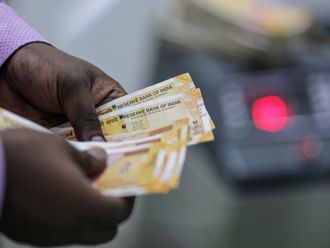New York: The dollar surged to its highest in more than three years against the yen and a three-month peak versus the euro on Friday, bolstered by a report showing the US economy created more jobs than expected last month, pushing the unemployment rate to a four-year low.
The greenback also posted its best weekly performance against the yen in two months. It also gained versus the euro for a fifth straight week.
The jobs report, suggesting the economy has developed enough momentum to withstand the blow from higher taxes and deep government spending cuts, fuelled speculation that the US Federal Reserve will tone down its ultra-loose monetary policy sooner than anticipated.
Data showed that non-farm payrolls surged in February, with employers adding 236,000 jobs, handily beating economists’ expectations for a gain of 160,000. The jobless rate fell in February to 7.7 per cent, the lowest since December 2008, from 7.9 per cent in January.
“Chants of ‘USA! USA!’ echoed on the trading floor (after) a very strong employment report was published this morning,” said Sean Cotton, vice president and foreign exchange advisor at Bank of the West in San Ramon, California.
“The data fits the story of an economy that has weathered the early stages of the fiscal drag extremely well.”
The euro fell against the dollar, erasing gains from Thursday when European Central Bank President Mario Draghi gave less dovish policy signals than expected. It dropped as low as $1.2955, its weakest level since December 11 and was last down 0.8 per cent at $1.2999.
Nearly $3 billion (Dh11 billion) in euros changed hands on Friday, using Reuters Dealing
On the back of better-than-expected US non-farm payroll figures, Rabobank has revised lower its three-month forecast for euro/dollar to $1.28 from $1.30. Over the next few weeks, the bank said the euro is likely to maintain a “jittery range” around the $1.29-$1.32 level.
Against the yen, the dollar climbed as high as 96.54 yen , its strongest level since August 2009. It was last at 96.11, up 1.4 per cent, the dollar’s best daily performance in almost a month.
Around $3.8 billion in yen were traded on the Reuters Dealing platform.
The yen seems likely to remain under pressure as investors, looking past the Bank of Japan’s decision to hold policy steady on Thursday at its April meeting, expect new officials to take aggressive action to beat deflation.
If the BoJ expands its stimulus program next month, that could open the way for a test of 100 yen, said Ronald Ip, director of wealth solutions group for HSBC Global Markets, in London.
BNY Mellon capital flows data showed that the US dollar has been steadily net bought for four consecutive sessions, with US stocks also largely in demand. Most of the US stock purchases came from foreign investors, which is another source of support for the dollar, the bank said.
“The summation of our investor activity in recent weeks suggests market participants have been increasingly favouring the dollar, which is no longer out of favour during risk-on investor sentiment, while still retaining its safe-haven allure during bouts of risk aversion,” said Samarjit Shankar, director of market strategy at BNY Mellon in Boston.
Euro steadies
The euro rose 0.5 per cent against the yen to 124.92 yen , with the session peak at 125.95 yen, the highest since February 13.
Investors’ expectations of future rate cuts in the euro zone, however, remained a focal point, reinforced by comments from International Monetary Fund head Christine Lagarde, who said the ECB should lower rates.
Jane Foley, senior currency strategist at Rabobank in London, acknowledged the downside risks currently lurking in the euro zone.
“The results of the Italian elections has so far failed to cause significant disruption in peripheral bond markets but the impact has the potential to breed uncertainties for weeks and even months,” Foley said.
In addition, Morgan Stanley analysts said in a note to clients that the downward revision of euro-zone growth forecasts and the below-target inflation forecast continued to provide the ECB with flexibility for future cuts in interest rates.
They said any rebound in the euro against the dollar was an opportunity to sell for an eventual decline toward $1.27/1.28.












